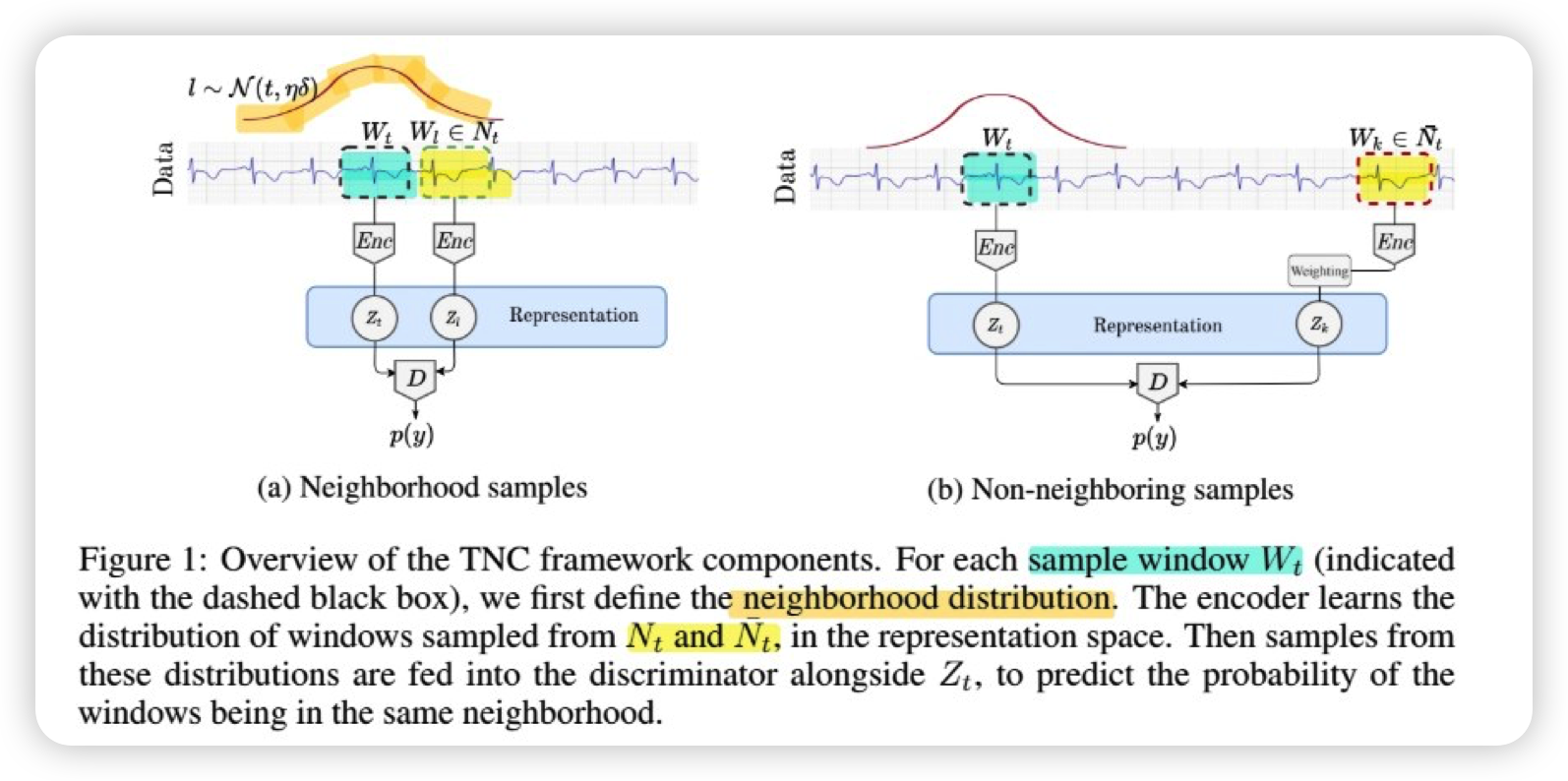Unsupervised Representation Learning for TS with Temporal Neighborhood Coding (2021, 14)
Contents
- Abstract
- Introduction
- Method
0. Abstract
Time Series : sparsely labeled
\(\rightarrow\) propose a SELF-supervised framework, for learning representation for non-stationary TS
TCN (Temporal Neighborhood Coding)
-
distribution of signals from within NEIGHBORHOOD
is distinguishable from the distribution of NON-neighborhood signals
1. Introduction
Unsupervised Representaiton Learning
-
extract informative LOW-dim representaiton from raw TS,
by leveraging the data’s inherent structure
Requirements
-
(1) need to be efficient and scalable
-
(2) should acount for & able to model dynamic changes that occur wihtin samples
( i.e non-stationarity )
This paper proposes “TCN”
-
self-supervised framework for learning representations for complex MULTIVARIATE NON-stationary TS
-
setting : latent distn of signals CHANGES OVER TIME
\(\rightarrow\) aims to capture the progression of underlying temporal dynamics
- characteristics
- (1) efficient
- (2) scalable to high-dim
- (3) can be used in different TS settings
- transferable to many downstream tasks
2. Method
-
encode the underlying state of multivariate, non-stationary TS
-
takes advantage of local smoothness of the generative process of signals
Notation
- \(X \in R^{D \times T}\) : MTS
-
\(X_{\left[t-\frac{\delta}{2}, t+\frac{\delta}{2}\right]}\) : window ……. refer as \(W_t\)
-
\(N_t\) : temporal neighborhood of window \(W_t\)
- set of all windows, with centroids \(t^{*}\), where \(t^{* } \sim N(t, \eta \cdot \delta)\)
- \(\eta\) : range of neighborhood
- how to set \(\eta\) ?
- (1) domain experts
- (2) determined by analyzing the stationarity properties of the signal for every \(W_t\)
- set of all windows, with centroids \(t^{*}\), where \(t^{* } \sim N(t, \eta \cdot \delta)\)
-
\(\bar{N_t}\) : non-neighborhood of window \(W_t\)
( considered as negative samples )
since nieghborhood represents similar samples,
-
range should identify the approximate time span within which the signal remains stationarity & the generative process does not change
-
use ADF test (Augmented Dickey-Fuller test to determine the region for every window
Value of \(\eta\)
-
too SMALL : many samples within neighborhood will OVERLAP
-
too BIG : the neighborhood would span over multiple ounderlying states
( fail to distinguish among these states )
Sampling bias
- occurs, because randomly drawing negative samples from data distn may result in negative samples, that are actually SIMILAR to the reference
- ex) far away from \(W_t\) ( = non-neighborhood ), but may be similar to reference
\(\rightarrow\) solution : consider samples from \(\bar{N_t}\) As…
- Unlabeled samples (O)
- Negative samples (X)
( idea from Positive-Unlabeled Learning )
PU Learning
classifier is learned using…
- (1) positive samples (P)
- (2) unlabeled data (U)
- mixture of P & N
- with a positive classs prior \(\pi\)
PU learning falls into 2 categories
- (1) identify negative samples from the unlabeled cohort
- (2) treat the unlabeled data as negative samples with smaller weights
- unlabeled samples should be properly weighted to make an unbiased classifier
Samples from…
- (1) neighborhood ( \(N_t\) ) : positive
- (2) non-neighborhood ( \(\bar{N_t}\) ) : combination of positive ( weight : \(w\) ) & negative ( weight : \(1-w\) )
- weight (\(w\)) : probability of having samples similar to \(W_t\) in \(\bar{N}\)
- (1) can be approximated using the prior knowledge
- (2) or tuned as hyperparameter
- weight (\(w\)) : probability of having samples similar to \(W_t\) in \(\bar{N}\)
After defining neighborhood distn…train an objective function
Key point of Encoder :
- preserve the neighborhood properties in the encoding space
- Notation
- \(Z_l = Enc(W_l)\) ….. where \(W_l \in N_t\)
- \(Z_k = Enc(W_k)\) ….. where \(W_k \in \bar{N_t}\)
2 main components of TNC
(1) Encoder : \(Z_t = Enc(W_t)\)
- maps \(W_t \in R^{D \times \delta}\) to \(Z_t \in R^{M}\)
(2) Discriminator : \(D(Z_t, Z)\)
- approximates the probability of \(Z\) being the representation of a window in \(N_t\)
- predicts the probability of samples belonging to the same temporal neighborhood
- details
- use a simple multi-headed binary classifier

